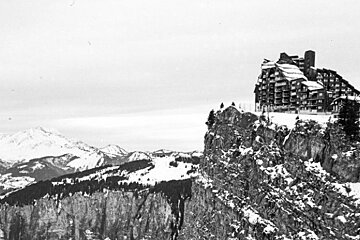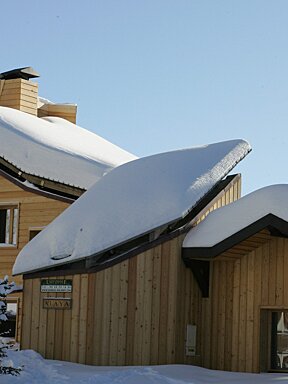
© Jacques Labro


© Ally MacLeod
History of Avoriaz
Discover the Avoriaz of yesterday
Possibly the most modern resort in the Portes du Soleil, Avoriaz is instantly recognisable for its dynamic architecture, based on the concept that in nature there are no right-angles.
However, back before winter sports transformed the resort Avoriaz, or ‘Avorea’ as it was known, was little more than a cluster of alpine chalets and high-altitude pastures.
Early history
Farmers from the lower village of Morzine would bring their cattle up the mountain to graze during the summer months. When winter arrived the harsh weather drove them back down to more sheltered land leaving the higher ground deserted. Back then skiing was not the popular and accessible pastime that it is today; the few hardy souls that trudged up through the heavy snow to ski back down had the mountains to themselves. One of these men was future Winter Olympic champion Jean Vuarnet.
Development through the ages
In 1960 Vuarnet became a local hero when he won the men’s downhill skiing at the Winter Olympics in Squaw Valley, California. On returning from his triumph he was made director in charge of transforming Avoriaz into a ski resort. Together with friends and business partners Gerard Bremont and Jacques Labro, amongst others, Vuarnet set about creating a viable infrastructure and generating interest in the resort. From the outset their plans were considered avant-garde and drew much criticism. The idea of making the resort traffic-free seemed absurd in the 1960’s when environmental issues were not on many people’s agenda and owning a car was a sign of affluence. However, the concept of leaving your car at the entrance and getting about on foot, sledge or even pony and trap is what gives Avoriaz much of its charm to modern day visitors. Vuarnet’s vision of Avoriaz as a ‘small Savoyard Colorado’ was totally different to the ideas that other, larger ski resorts were developing along. However, he and his associates knew that they were with working with a relatively small village that, geographically, could not expand outwards and so a more lateral approach would be necessary to carry out the development.
The Nyon cable car and the Avoriaz cable car were completed by 1961; the Prodains cable car was swift to follow in 1963. By Christmas 1966 the resort was welcoming its first winter guests. In the same season Jacques Labro built the Hotel les Dromonts and his futuristic design set the tone for the rest of the resort.
Recent history
The architects of Avoriaz have since embraced the bold lines and sharp angles of its cliff top location rather than the ‘chocolate box’ chalet design that we tend to associate with ski resorts. However, despite being built in the 1960’s (the same era when many ‘concrete jungle’ ski resorts were hastily constructed) the overall visual impact of the resort is surprisingly in keeping with its natural surroundings. The buildings are mainly fabricated from wood and slate and blend well into the colours of the cliffs. Many of the designers that have contributed to the development of Avoriaz in the intervening years have won prestigious awards ie Académie des Beaux Arts, the Equerre d’Argent and a silver medal from the Architectural Académie. In 2003 Avoriaz was awarded a prize by the Minister of Culture for being one of the great heritage achievements of the 20th century.
It was not just the skiing that drew in the visitors. In 1973 Avoriaz hosted the first ‘Fabulous Film Festival’; an annual event that would rival Cannes and ran until 1993. The festival attracted big names such as Robert de Niro and Roman Polanski and showcased hit films such as Steven Spielberg's 'Duel' and Brian de Palma's 'Carrie'.
These days Avoriaz is firmly on the map as a popular winter resort with the vast ski area of the Portes du Soleil at its disposal. It also has a thriving summer scene and is becoming increasingly well known for its mountain biking events and beautiful hiking trails.






























